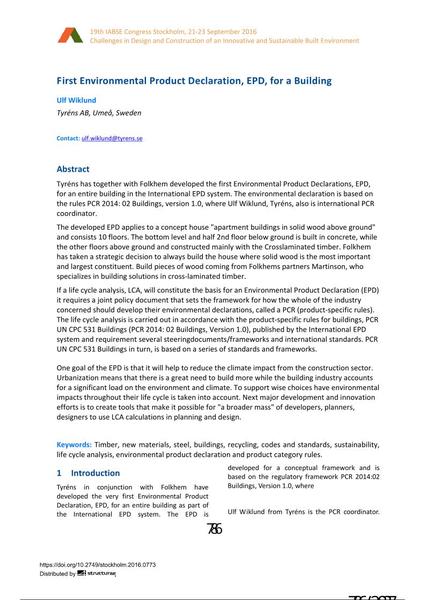First Environmental Product Declaration, EPD, for a Building

|
|
|||||||||||
Détails bibliographiques
| Auteur(s): |
Ulf Kjell Christer Wiklund
(Tyréns AB, Umeå, Sweden)
|
||||
|---|---|---|---|---|---|
| Médium: | papier de conférence | ||||
| Langue(s): | anglais | ||||
| Conférence: | IABSE Congress: Challenges in Design and Construction of an Innovative and Sustainable Built Environment, Stockholm, Sweden, 21-23 September 2016 | ||||
| Publié dans: | IABSE Congress Stockholm, 2016 | ||||
|
|||||
| Page(s): | 786-793 | ||||
| Nombre total de pages (du PDF): | 8 | ||||
| Année: | 2016 | ||||
| DOI: | 10.2749/stockholm.2016.0773 | ||||
| Abstrait: |
Tyréns has together with Folkhem developed the first Environmental Product Declarations, EPD, for an entire building in the International EPD system. The environmental declaration is based on the rules PCR 2014: 02 Buildings, version 1.0, where Ulf Wiklund, Tyréns, also is international PCR coordinator. The developed EPD applies to a concept house "apartment buildings in solid wood above ground" and consists 10 floors. The bottom level and half 2nd floor below ground is built in concrete, while the other floors above ground and constructed mainly with the Crosslaminated timber. Folkhem has taken a strategic decision to always build the house where solid wood is the most important and largest constituent. Build pieces of wood coming from Folkhems partners Martinson, who specializes in building solutions in cross-laminated timber. If a life cycle analysis, LCA, will constitute the basis for an Environmental Product Declaration (EPD) it requires a joint policy document that sets the framework for how the whole of the industry concerned should develop their environmental declarations, called a PCR (product-specific rules). The life cycle analysis is carried out in accordance with the product-specific rules for buildings, PCR UN CPC 531 Buildings (PCR 2014: 02 Buildings, Version 1.0), published by the International EPD system and requirement several steeringdocuments/frameworks and international standards. PCR UN CPC 531 Buildings in turn, is based on a series of standards and frameworks. One goal of the EPD is that it will help to reduce the climate impact from the construction sector. Urbanization means that there is a great need to build more while the building industry accounts for a significant load on the environment and climate. To support wise choices have environmental impacts throughout their life cycle is taken into account. Next major development and innovation efforts is to create tools that make it possible for "a broader mass" of developers, planners, designers to use LCA calculations in planning and design. |
||||
| Mots-clé: |
acier durabilité bâtiment nouveau matériau
|
||||
